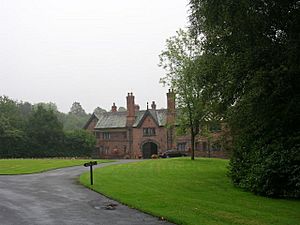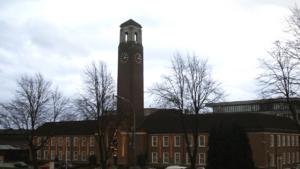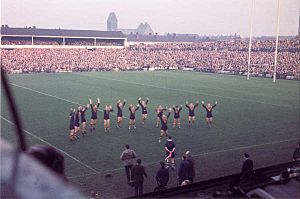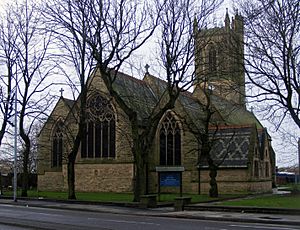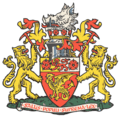Swinton, Greater Manchester facts for kids
Quick facts for kids Swinton |
|
|---|---|
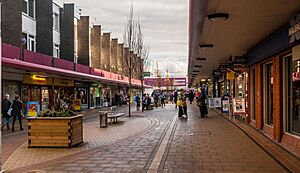 Swinton town centre |
|
| Population | 22,931 (2014 estimate) |
| OS grid reference | SD775015 |
| • London | 167 mi (269 km) SE |
| Metropolitan borough | |
| Metropolitan county | |
| Region | |
| Country | England |
| Sovereign state | United Kingdom |
| Post town | MANCHESTER |
| Postcode district | M27 |
| Dialling code | 0161 |
| Police | Greater Manchester |
| Fire | Greater Manchester |
| Ambulance | North West |
| EU Parliament | North West England |
| UK Parliament |
|
Swinton is a town in Greater Manchester, England. It is part of the City of Salford. Swinton is about 4 miles (6.4 km) northwest of Manchester. It is located near the River Irwell. In 2014, about 22,931 people lived there.
Swinton has a long history. It was once a small village in Lancashire. The name "Swinton" comes from an old English word. It means "swine town," which means "pig town." For many years, people in Swinton mostly farmed. They also wove wool at home to earn extra money.
During the Industrial Revolution, coal mines opened in Swinton. This made it an important industrial area. Coal powered the cotton spinning and brick-making factories. Bricks from Swinton were even used to build the Bridgewater Canal. This canal runs south of Swinton. Many factories and new roads were built. Swinton grew into a busy town with mills and coal mines.
In 1894, Swinton joined with nearby Pendlebury. They formed an urban district in Lancashire. In 1934, Swinton and Pendlebury became a borough. This gave them special town status. The first major intercity highway in the UK, the A580, opened in the same year. King George V officially opened it. Swinton and Pendlebury became part of the City of Salford in 1974. Today, Swinton is where the Salford City Council meets. It is also a town where many people live and travel to work in Manchester.
Contents
History of Swinton
The name Swinton comes from old English words. Swin means pigs and tun means an enclosed area or farm. So, Swinton means "pig farm" or "pig town."
In the Middle Ages, Swinton belonged to a place called Whalley Abbey. Some parts of Swinton were also owned by the Knights Hospitaller. They were a religious and military group.
In 1817, some weavers from Swinton joined a protest. They marched to London to share their problems with the Prince Regent. In 1842, some people from Swinton took part in Chartism protests. They even tried to damage a local coal mine.
Sunday schools and libraries started early in Swinton. The Swinton Industrial School opened in 1843. It was a special place for children who were poor. Unlike other places, this school aimed to care for and educate children. Famous writer Charles Dickens even visited it. The school closed in the 1920s. The land where it stood is now home to the town hall.
How Swinton is Governed
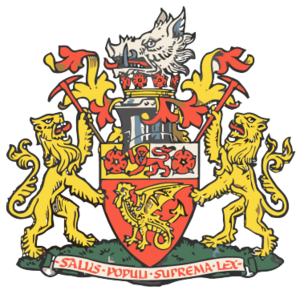
Swinton has been part of Lancashire since the 1100s. Its first local government was set up in 1867. This group was called a local board of health. It made sure the town was clean and healthy. In 1869, it became the Swinton and Pendlebury Local Board of Health.
In 1894, Swinton became a separate civil parish. It joined with Pendlebury to form an urban district. This was a type of local government area. Over the years, Swinton and Pendlebury grew. It added parts of nearby Clifton and Prestwich.
On 29 September 1934, Swinton and Pendlebury officially became a municipal borough. This gave it more power to manage its own affairs. However, in 1974, big changes happened in local government. Swinton and Pendlebury became part of the City of Salford. Today, Swinton is an important part of Salford.
Geography of Swinton
 |
Kearsley | Clifton | Prestwich |  |
| Worsley, Wardley | Pendlebury | |||
| Eccles | Pendleton | Irlams o' th' Height |
Swinton is located at 53.5122° North, 2.3412° West. It is about 167 miles (269 km) northwest of central London. It is also about 4.2 miles (6.8 km) west-northwest of Manchester city centre.
The town is on gently sloping land. It is about 213 feet (65 meters) above sea level. The River Irwell flows to the north of Swinton. Swinton is part of the large urban area of Greater Manchester. The M60 motorway passes by Swinton on its northwest side.
Important Buildings and Landmarks
The most famous building in Swinton is the Salford Civic Centre. It has a tall clock tower that is 125 feet (38 meters) high. This building was first built as the Swinton and Pendlebury Town Hall. It was needed because the old council meeting place was too small.
Architects Percy Thomas and Ernest Prestwich designed the building. Their design looked a lot like Swansea Guildhall. It even won a special award for its design. Construction started in 1936 and finished in 1938. When Swinton became part of the City of Salford in 1974, this building became the main office for Salford.
Wardley Hall is a very old medieval house. It is a Grade I listed building, meaning it is very important. It is the official home of the Roman Catholic bishops of Salford.
Transport in Swinton
Swinton has two railway stations. They are on the line that goes from Manchester to Southport. Swinton railway station is close to the town centre. It is on Station Road. The other station is Moorside railway station. It is near Moorside Road.
Many bus routes also run through Swinton. You can take a bus to Manchester city centre, Bolton, and other places.
Sports in Swinton
Swinton RLFC is a famous rugby league team. They have won the Championship six times and the Challenge Cup three times. This is a great record for a town of Swinton's size. The club used to play at Station Road until 1992. They have moved to different stadiums since then. Currently, they play their home games at Heywood Road in Sale.
A local junior football team, Deans F.C., was where famous football player Ryan Giggs started his career. He grew up in nearby Pendlebury. Dean Holden also started playing football at Deans F.C.
Schools in Swinton
Primary Schools
- Mossfield Primary School
- Broadoak Primary School
- The Deans Primary School
- Grosvenor Road Primary School
- Moorside Primary School
- St Charles' RC Primary School
- St Mary's RC Primary School
- St Peter's CE Primary School
- Wardley CE Primary School
About St Peter's CE Primary School
St Peter's CE Primary School (53°30′43″N 2°20′33″W / 53.51194°N 2.34250°W) is a Church of England primary school. It is on Vicarage Road in Swinton. The school is next to St Peter's Church. It is also very close to Swinton Shopping Centre and Salford Civic Centre.
St Peter's School has two main parts: Juniors and Infants. Like most primary schools in England, it teaches children from ages 3 to 11. This includes children in Years 1 to 6. In 2011, it was a very popular primary school in Salford. St Peter's is a school that sends its students on to Moorside High School.
The school building was not always in its current spot. The first school from the 1800s was where the Swinton Shopping Centre is now. A bigger building was needed. The current school building was built between 1905 and 1906. It opened its doors in 1906 and has been used ever since.
The school has received several awards. It got the Basic Skills Quality Mark in 2005. It also received the Healthy Schools Award and the Artsmark Silver Award in 2006.
The school has put on many plays. These include Joseph and the Amazing Technicolor Dreamcoat in 2001 and 2008. They also performed Alice in Wonderland in 2002 and Oliver! in 2003.
Some famous people who used to go to St Peter's include:
- Brett Cullen, who was a stunt double in the movie Guardians of the Galaxy Two.
- CBBC Presenter Chris Johnson, who attended from 2000 to 2002.
- Salford City Radio Presenter Lewis Ryan, who attended until 2002.
Secondary Schools
- Moorside High School, Deans Road, Swinton
- St Ambrose Barlow RC High School, Ash Drive, Wardley, Swinton
- Co-op Academy Swinton
Churches in Swinton
- St Peter's C of E, Chorley Road, Swinton
- All Saints' C of E, Charles Street, Swinton
- Holy Rood C of E, Moorside Road, Swinton
- St Charles' RC, Moorside Road, Swinton
- United Reformed, Worsley Road, Swinton
- Worsley Road Methodist, Worsley Road, Swinton
- Latter-Day Saints, Partington Lane, Swinton
- Bethesda Hall, Worsley Road, Swinton
- Manchester Road Methodist, Manchester Road, Swinton
- Jehovah's Witnesses, Swinton Hall Road, Swinton
Notable People from Swinton
- Composer Sir Peter Maxwell Davies grew up in Swinton. He was once the Queen's official composer. In 1998, he wrote a piece called Swinton Jig. It was inspired by the sounds he heard in Swinton when he was a child.
- Composer and pianist Roger Smalley was born in Swinton in 1943.
- Cricketer Charles Woods (1878–1940) was born in Swinton.
Images for kids
See also
 In Spanish: Swinton (Gran Mánchester) para niños
In Spanish: Swinton (Gran Mánchester) para niños



